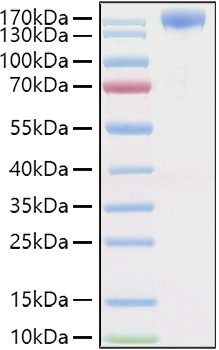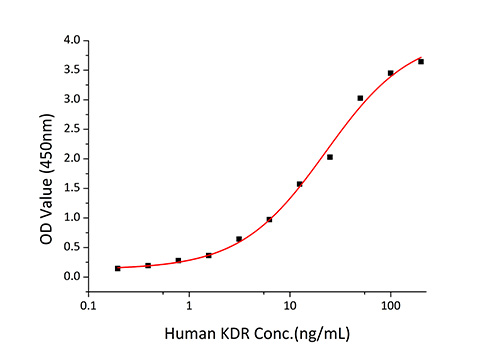Description
Recombinant Human VEGFR-2/KDR/CD309 Protein
The Recombinant Human VEGFR-2/KDR/CD309 Protein is a biologically active recombinant protein that plays a significant role in various cellular processes and signaling pathways in human biology. This protein is widely employed in immunological research, cell biology studies, protein-protein interaction analyses, and therapeutic development, providing researchers with a reliable tool for investigating VEGFR-2/KDR/CD309 function and its implications in health and disease.
This product (SKU: RPCB0983) is produced using HEK293 cells and features a C-hFc&His tag for convenient detection and purification. The protein exhibits a calculated molecular weight of 110.06 kDa with an observed molecular weight of 160-170 kDa under denaturing conditions, achieving ≥ 95 % as determined by SDS-PAGE.. Functional bioactivity has been validated through rigorous quality control assays, confirming its suitability for demanding research applications.
Key Features
| High Purity by Affinity Chromatography | |
| Mammalian & Bacterial Expression Systems | |
| High lot-to-lot consistency via strict QC |
| Product Name: | Recombinant Human VEGFR-2/KDR/CD309 Protein |
| SKU: | RPCB0983 |
| Size: | 10 μg , 50 μg , 100 μg |
| Reactivity: | Human |
| Synonyms: | CD309, FLK1, VEGFR, VEGFR2, VEGF Receptor 2, KDR |
| Tag: | C-hFc&His |
| Expression Host: | HEK293 cells |
| Calculated MW: | 110.06 kDa |
| Observed MW: | 160-170 kDa |
| Gene ID: | 3791 |
| Protein Description: | High quality, high purity and low endotoxin recombinant Recombinant Human VEGFR-2/KDR/CD309 Protein (RPCB0983), tested reactivity in HEK293 cells and has been validated in SDS-PAGE.100% guaranteed. |
| Endotoxin: | < 0.1 EU/μg of the protein by LAL method. |
| Purity: | ≥ 95 % as determined by SDS-PAGE. |
| Formulation: | Lyophilized from a 0.22 μm filtered solution of PBS, pH 7.4. |
| Bio-Activity: |
|
| Reconstitution: | Centrifuge the vial before opening. Reconstitute to a concentration of 0.1-0.5 mg/mL in sterile distilled water. Avoid vortex or vigorously pipetting the protein. For long term storage, it is recommended to add a carrier protein or stablizer (e.g. 0.1% BSA, 5% HSA, 10% FBS or 5% Trehalose), and aliquot the reconstituted protein solution to minimize free-thaw cycles. |
| Storage: | Store at -20℃.Store the lyophilized protein at -20℃ to -80 ℃ up to 1 year from the date of receipt. After reconstitution, the protein solution is stable at -20℃ for 3 months, at 2-8℃ for up to 1 week. |
Kinase insert domain receptor (KDR) is also known as CD309, FLK1, VEGFR, VEGFR2, and is one of the subtypes of VEGFR. VEGF receptors are receptors for vascular endothelial growth factor (VEGF). VEGFR2 was shown to be the primary signal transducer for angiogenesis and the development of pathological conditions such as cancer and diabetic retinopathy. It has been shown that VEGFR2 is expressed mainly in the endothelial cells, and the expression is upregulated in the tumor vasculature. Thus the inhibition of VEGFR2 activity and its downstream signaling are important targets for the treatment of diseases involving angiogenesis. VEGFR2 transduces the major signals for angiogenesis via its strong tyrosine kinase activity. However, unlike other representative tyrosine kinase receptors, VEGFR2 does not use the Ras pathway as major downstream signaling but rather uses the phospholipase C-protein kinase C pathway to signal mitogen-activated protein (MAP)-kinase activation and DNA synthesis. VEGFR2 is a direct and major signal transducer for pathological angiogenesis, including cancer and diabetic retinopathy, in cooperation with many other signaling partners; thus, VEGFR2 and its downstream signaling appear to be critical targets for the suppression of these diseases. VEGF and VEGFR2-mediated survival signaling are critical to endothelial cell survival, maintenance of the vasculature and alveolar structure, and regeneration of lung tissue. Reduced VEGF and VEGFR2 expression in emphysematous lungs has been linked to increased endothelial cell death and vascular regression.








